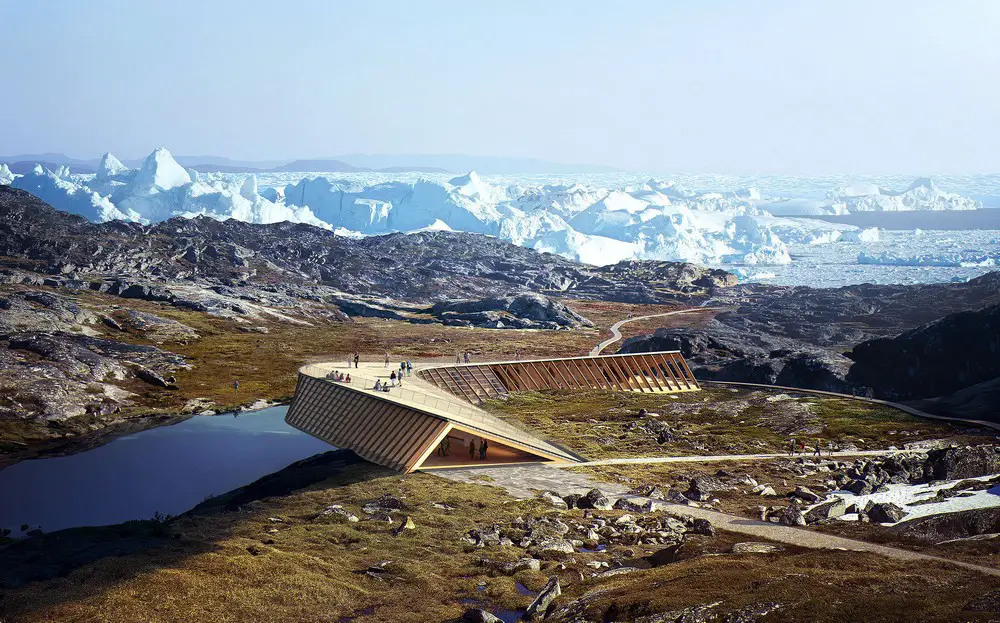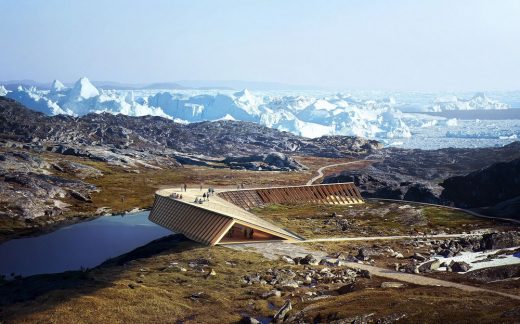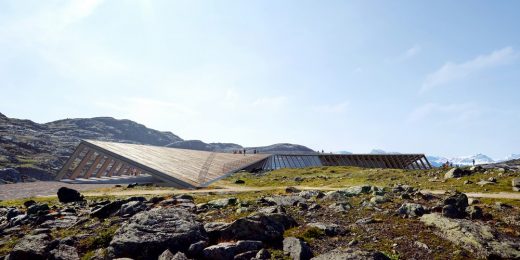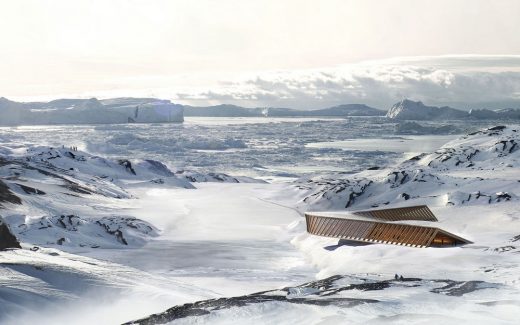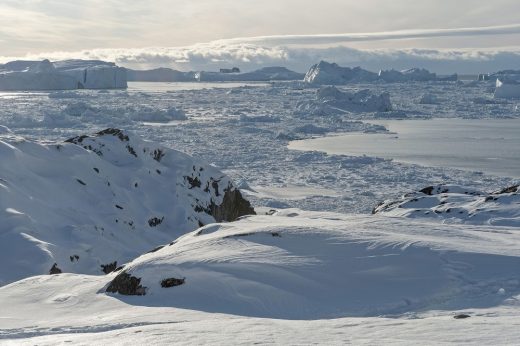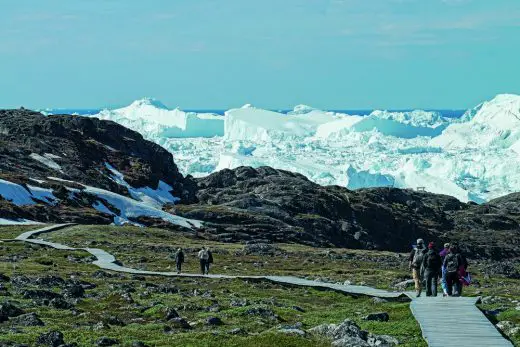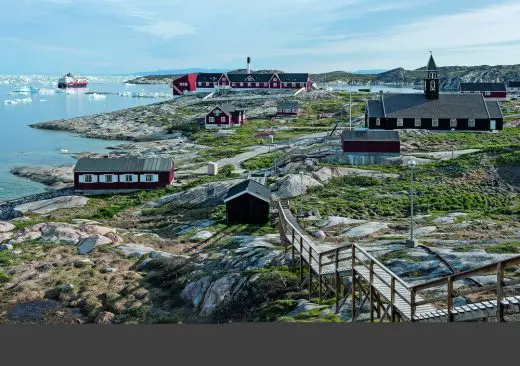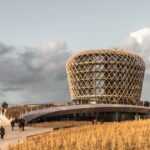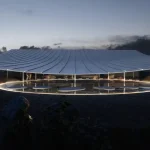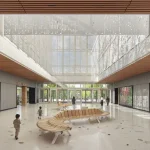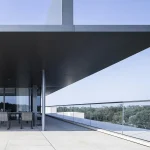Icefjord Centre, Ilulissat Visitors Centre, Architect, Building Design, Architecture Images
Icefjord Centre in Ilulissat
Visitors Centre in Greenland by Dorte Mandrup Architects
9 September 2021
Icefjord Centre In Greenland, Ilulissat, Greenland
Design: Dorte Mandrup Arkitekter
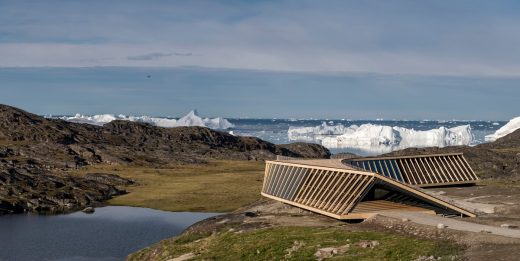
photo : Adam Mørk
Ilulissat Icefjord Centre Building
Overlooking the Kangia Icefjord on the west coast of Greenland, 250 km north of the Arctic Circle, the building blends effortlessly into the landscape and offers a unique vantage point from which to experience the astonishing Icefjord and understand the dramatic consequences of climate change on this remarkable landscape.
22 Jun 2016
Design: Dorte Mandrup Arkitekter
Location: Ilulissat, Greenland
The first lines have been drawn for a global attraction at Ilulissat Icefjord
Icefjord Centre
An Icefjord Centre in Ilulissat will attract tourists to Greenland and contribute to our understanding of climate change. The Danish architectural firm Dorte Mandrup Arkitekter has designed the visionary building for the centre with respect of the unique, UNESCO-protected natural surroundings.
The vision of a world-class tourist attraction in Ilulissat has come one step closer to realization with the selection of Dorte Mandrup Arkitekter’s proposal for an Icefjord Centre. The centre will help develop Greenland’s tourism and will serve as a global portal to understanding the ice fjord and, not least, its culture and history as well as the dramatic melting of the Greenland ice sheet. The parties behind the centre are the Greenland Government, Qaasuitsup Municipality and Realdania.

image : Dorte Mandrup Architects
The winning project is a simple, twisting structure resembling a wing stretching across the landscape. “The flight of a snowy owl” was the poetic vision of the architects. The building will be a natural extension of existing hiking trails in the area, with the possibility of continuing the hike onto the roof of the building to enjoy the unique view of the ice fjord and the surrounding landscape. The open facade generates dialogue between the exhibition inside and the building’s natural surroundings; a dialogue between man and nature. The basic idea is that the building should have as little impact on the fragile landscape as possible.
“We selected the proposal from Dorte Mandrup Arkitekter as the winning project because it is a very poetic and visionary project with an architectural unity that underpins the overall vision beautifully. The new building will streamline smoothly with the spectacular natural landscape,” said Jan Søndergård, who is the spokesman for the assessment panel and a professor at the Royal Danish Academy of Fine Arts and partner in KHR arkitekter.
The Icefjord Centre at Ilulissat will open its doors to the public in autumn 2020 and is expected to have up to 25,000 visitors annually. The Greenland Government, Qaasuitsup Municipality and Realdania signed a partnership agreement for the building project in 2015. The philanthropic association Realdania is contributing DKK 83 mill., while the Government of Greenland is contributing DKK 15 mill. and Qaasuitsup Municipality DKK 8 mill. Furthermore, work is ongoing to raise donations of up to DKK 10 mill. for the exhibition and for activities inside the Centre. The two international foundations Bloomberg Philanthropies and the OAK Foundation have each made donations. In the longer term, the Icefjord Centre will be self-sustaining, financed by its own revenues.
For Greenland and Ilulissat, the Icefjord Centre will open for new opportunities to increase the already growing stream of tourists from all around the world. The Ilulissat ice fjord caught the attention of the world in 2004 when it was designated as a world heritage site by UNESCO, because of its unique significance for glaciological science and its outstanding nature. Growing tourism will mean more jobs, revenues and development for the area. According to the tourism strategy for Greenland, the centre is the first of five envisioned visitors’ centres, which together will take Greenland to a whole new level as a tourist destination. The idea is that the many nature experiences and cultural heritage narratives that Greenland has to offer will be communicated at several experience centres geographically across different regions in Greenland, inspired by centres such as the Norwegian Glacier Museum & Ulltveit-Moe Climate Centre in Fjærdal, Norway and the Thingvellir National Park in Iceland. The Icefjord Centre will also serve as a gathering point and activity centre for the local community.
Vittus Qujaukitsoq, Minister for Industry, Labour, Trade and Foreign Affairs, Government of Greenland, said:
“Promoting tourism is high on the Government agenda. One of the cornerstones of our new strategy for tourism is to set up regional visitor centres. Therefore, I’m extremely pleased to see the Icefjord Centre taking shape. Our partnership with Realdania is a vital contribution to developing tourism in the years to come.”
Ole Dorph, Mayor of Qaasuitsup Municipality, said:
“We’re very happy to see the great interest in helping to build the Icefjord Centre that will make Ilulissat and Disko Bay an even more impressive attraction than it is today and that will disseminate knowledge about the ice fjord, and the Arctic climate and living conditions.”
Construction work will be managed by Realdania, and through its Realdania By & Byg subsidiary, will have the building ready for the first tourists, researchers and local visitors in 2020.
Jesper Nygård, CEO of Realdania, said:
“The Icefjord Centre will provide a front-row seat for the melting ice sheet and it will communicate the tangible consequences of climate change to us all. We are confident that the Icefjord Centre will be a significant contribution to the development of tourism in Ilulissat and Greenland as a whole, and not least become a global gathering point for research and climate debate. We now have a world-class architectural solution that underpins such a vision and which will take its place respectfully on the edge of the unique World Heritage Site.”
Ilulissat and the ice fjord are already attracting many glaciologists, heads of states and tourists with an interest in climate change. Ever more researchers are setting up camp around this active glacier in attempts to decode the past, present and future of climate change. The Icefjord Centre will underpin Greenland as the centre of global climate debate and research.
Icefjord Centre in Ilulissat – Building Information
About Qaasuitsup Municipality
With an area of 660,000 km2, Qaasuitsup Municipality is the world’s largest and most northerly municipality. Qaasuitsup means ‘place with polar darkness’. The principal city is Ilulissat and the municipality comprises eight towns and 31 settlements with a total of about 18,000 inhabitants.
About the Greenland Government
In 2009, the Government of Greenland (Selvstyret) replaced the Home Rule (Hjemmestyret) that was established in 1979. Naalakkersuisut is the government itself, elected by Inatsisartut, (the Parliament of Greenland). There are nine members of the current Naalakkersuisut, led by the Chairman of the Parliament.
About Realdania
Realdania is a philanthropic association working within the built environment with the primary goal of improving the quality of life. Realdania works with houses and buildings, in areas between buildings, in cities, and in villages. This is usually with other players, e.g. municipalities, companies, associations and foundations.
Other facts
Financing
The total budget is DKK 116 mill. Realdania is contributing DKK 83 mill., while the Government of Greenland and Qaasuitsup Municipality are contributing DKK 23 mill. Furthermore, work is ongoing to raise donations of up to DKK 10 mill. for the exhibition and activities inside the Centre. The two international foundations Bloomberg Philanthropies and the OAK Foundation have each made donations.
Operations
A manager and a small staff will be responsible for day-to-day operation of the Centre. In the initial years, operations will be supported through a service contract with the Government of Greenland until visitor numbers grow by enough to make the Icefjord Centre financially self-sufficient. Approximately 25,000 are expected to visit the Centre after it opens, and this number is expected to grow over the years.
Dorte Mandrup Arkitekter – the team behind the Centre
The winning team with Dorte Mandrup Arkitekter as the coordinating contractor consists of: Arkitekt Kristine Jensens Tegnestue (the landscape project), Nøhr & Sigsgaard Arkitektfirma, Masanti Arkitekter og Ingeniører, and Søren Jensen Rådgivende Ingeniørfirma. Niels Bennetzen (urban planning consultant) and Professor of Geology, Minik Thorleif Rosing (from the Geological Museum at the Natural History Museum of Denmark, University of Copenhagen) are consultants on the project.
Dorte Mandrup Arkitekter was founded in 2001 and is based in Copenhagen. The firm is behind several award-winning culture and sports projects in Copenhagen, such as Kvarterhuset, Prismen and Børnekulturhuset AMA’R. The firm also designed the Wadden Sea Centre, a nature information center for the UNESCO-listed Wadden Sea.
Arkitekt Kristine Jensens Tegnestue has won a number of competitions in Denmark and Scandinavia, and is behind projects such as the Jelling monument site and Moesgaard Museum.
Other architectural firms in the competition
The other architectural firms in the competition were: Arkís Arkitektar (Iceland), Kengo Kuma and Associates (Japan), Rintala Eggertsson Architects (Norway), Snøhetta (Norway), Studio Other Spaces (props. Olafur Eliasson and Sebastian Behmann) (Germany).
Assessment Panel
Lars Autrup (chair), head of project, Realdania.
Thue Christiansen, artist, representative of the Government of Greenland.
Ono Fleischer, representative of Qaasuitsup Municipality, Greenland.
Hans Peter Svendler, special adviser.
Technical specialists:
Professor Jan Søndergaard, architect, partner in KHR Arkitekter.
Torben Schønherr, landscape architect, senior partner in Schønherr A/S.
Professor Carsten Rode, engineer, DTU Civil Engineering.
Competition consultants
ARKITEKTKONKURRENCERDK, Rambøll, BARK (formerly Dansk Bygningsarv), JAC Studios and Tegnestuen Jens V. Nielsen.
The next four years
June 2016: Selection of the winning project
2017: Final content and design of the exhibition decided
Summer 2017: Successful proposal fully developed and drawn
Summer 2017: Site preparation; i.e. sewerage, electricity and water connections
Spring 2018: Construction commences
2019: Exhibition content produced
Spring 2020: Building complete, internal furnishing and fitting out commences
October 2020: Open to the public
Functionality at the Icefjord Centre
About half of the 900-square-metre building will be an exhibition area. The Icefjord Centre will also house the present Icefjord Office, which administrates the UNESCO World Heritage. There will also be a café, shop and field station for researchers.
The exhibition
Three themes will serve as the cornerstones of the Icefjord Centre’s exhibition. Ice and landscape – how ice forms as snowflakes on the Greenland ice sheet and ultimately ends up as icebergs in the fjord. Cultural heritage and civilization – why ice is so life-giving and has helped shape the more than 4,000-year-old Inuit culture along the fjord. Climate change – why ice is life-changing and has an enormous influence on the local and global climate. In addition to the dramatic narrative about the ice, visitors can also sit down for a rest and a bite to eat in the Centre’s experience room.
Advisory Board
An advisory group of relevant experts from Greenland, Denmark, Norway and Iceland has been linked to the Centre. The group will advise about the ambitious exhibition that will form the core of the visitor experience at the Icefjord Centre. The group has been selected very carefully on the basis of professional and academic competences within climate, research and communication.
The members are: Klaus Nygaard (Director of Greenland Institute of Natural Resources), Olav Orheim (Norwegian glaciologist and climate researcher), Kirsten Hastrup (Professor of anthropology and Greenland researcher, University of Copenhagen), Erik Bjerregaard (Director of Hotel Arctic in Ilulissat and member of the board of Visit Greenland), Òlafur Orn Haraldsson (Director of Thingvellir Visitor Centre in Iceland).
More attractions under development
To ensure that Ilulissat becomes a destination that can offer tourists several days of activity, the Ilimanaq settlement south of the Ilulissat Icefjord will also be developed. Two listed historic buildings from the 1700s will be restored and turned into places to eat and meet for tourists, who will have 15 new luxury chalets to stay in. The buildings will also sell local arts and crafts and local delicacies. In addition to the Icefjord Centre and Ilimanaq, tourists can seek out adventure on Disko Island, the Oqaatsut settlement and Glacier Lodge Eqi. The Ilimanaq project is a collaboration between Qaasuitsup Municipality (infrastructure), World of Greenland (chalets) and Realdania By & Byg (owner and responsible for restoring the buildings).
The Ilulissat Icefjord
Kangia is the Greenlandic name for the ice fjord. It is one of the most spectacular natural habitats in the world. It is located by Ilulissat in West Greenland, 250 km north of the Arctic Circle. The icebergs in the fjord are calved from Sermeq Kujalleq, the largest and most active glacier in the northern hemisphere, with an area of 3,000 km2 and lying at the bottom of the approximately 60-kilometer-long ice fjord. The glacier moves by up to 40 meters a day and calves more than 46 km3 of ice every year, corresponding to 10% of all the ice calved from Greenland. Some of the oldest ice in Sermeq Kujalleq has been estimated to be 250,000 years old. In recent years, the glacier has retreated by many kilometers due to melting of the Greenland ice sheet.
UNESCO World Heritage
In 2004, the entire region around Kangia and Sermeq Kujalleq was the first area in Greenland to be included on the UNESCO World Heritage List. The ice fjord was included because of its unique significance for glaciological science and its astounding nature. The area has traces of early Greenland settlements, for example around the Sermermiut settlement.
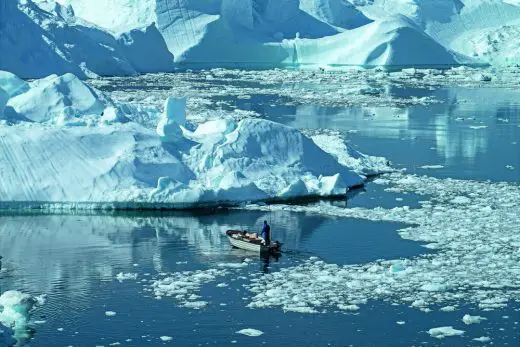
image : Jens V. Nielsen
Icefjord Centre in Ilulissat images / information from Dorte Mandrup Arkitekter
Dorte Mandrup Arkitekter on e-architect
Location: Ilulissat, Greenland
Greenland Architecture
Greenland Building Developments – chronological list
Greenland Buildings by Danish architects on e-architect:
Greenland National Gallery of Art
BIG + TNT Nuuk + Ramboll Nuuk + Arkitekti
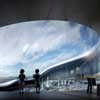
image from BIG
Greenland National Gallery of Art
Nuuk Correctional Facility Building
Design: schmidt hammer lassen architects with Friis & Moltke
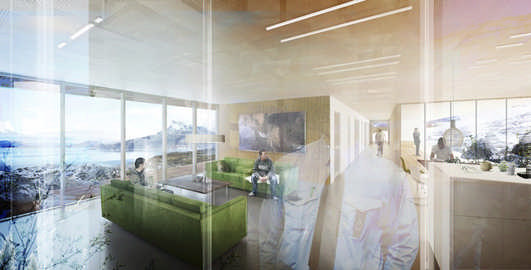
image from architects
Nuuk Correctional Facility Greenland
Katuaq – Grønlands Kulturhus, Nuuk
Schmidt Hammer Lassen Architects
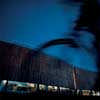
photo : Joachim Ladefoged
Grønlands Kulturhus Nuuk
Queen Ingrid Hospital, Godthåb
C. F. Møller Architects
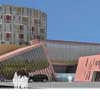
picture : C. F. Møller, Architects
Queen Ingrid Hospital Building
Thor Heyerdahl School of Advanced and Further Education, Larvik, Norway
Thor Heyerdahl School
Comments / photos for the Icefjord Centre in Ilulissat Building page welcome
Website: Dorte Mandrup Arkitekter

